Considering a move into high-level tech management? An IT director role combines strategic vision with technical expertise. This guide offers a clear roadmap to learn the essential steps needed to build a strong IT career path. The director of IT position is defined by its precise IT director job description, which outlines key responsibilities in tech management. Industry data shows that the information technology director salary ranges from $127,000 to over $208,000 annually in the United States. Whether exploring IT jobs or aiming to become a tech director, prepare for a rewarding journey in this field.
What is an IT Director?
An IT Director leads an organization’s technology team. The IT Director plans and manages the company’s IT operations. This role includes setting plans for technology use, managing teams, and keeping the computer systems safe. The IT Director works with other managers to support the business. This guide shows you how to build the skills needed to take this role.
What is the Role of an IT Director?
An IT Director makes key decisions for a company’s computer systems. The IT Director sets the goals for the IT department. The IT Director works with staff to solve problems. The IT Director helps to plan for new technology and upgrades. The IT Director also works with vendors to get the best equipment and software for the company.
What are the Steps to Build Your IT Career?
Follow these steps to prepare for a role as an IT Director and build a strong IT career.
Start with Basic IT Roles
A career in IT begins with roles such as Help Desk Technician, Systems Administrator, or Network Engineer. These jobs provide training in computer support, network maintenance, and system troubleshooting. Entry-level positions offer a strong base in IT.
Gain Experience in Mid-Level Jobs
After entry-level experience, a transition to mid-level jobs is common. Positions like IT Manager, Systems Analyst, or Project Manager involve handling projects and leading small teams. These roles require collaboration with other parts of the company to resolve issues. Each job helps build skills in managing people and technology.
Advance to Senior Roles
With further experience, the next step is to move into senior roles. Positions such as Director of IT Operations or Director of Information Systems involve planning for the entire IT department. Senior roles require working with senior management to set goals and budgets. These roles prepare an individual for the IT Director position.
Many IT Directors later become Chief Technology Officers (CTO) or Chief Information Officers (CIO). These roles include more business planning and decision-making. However, the IT Director role remains vital because it connects technology with company plans.
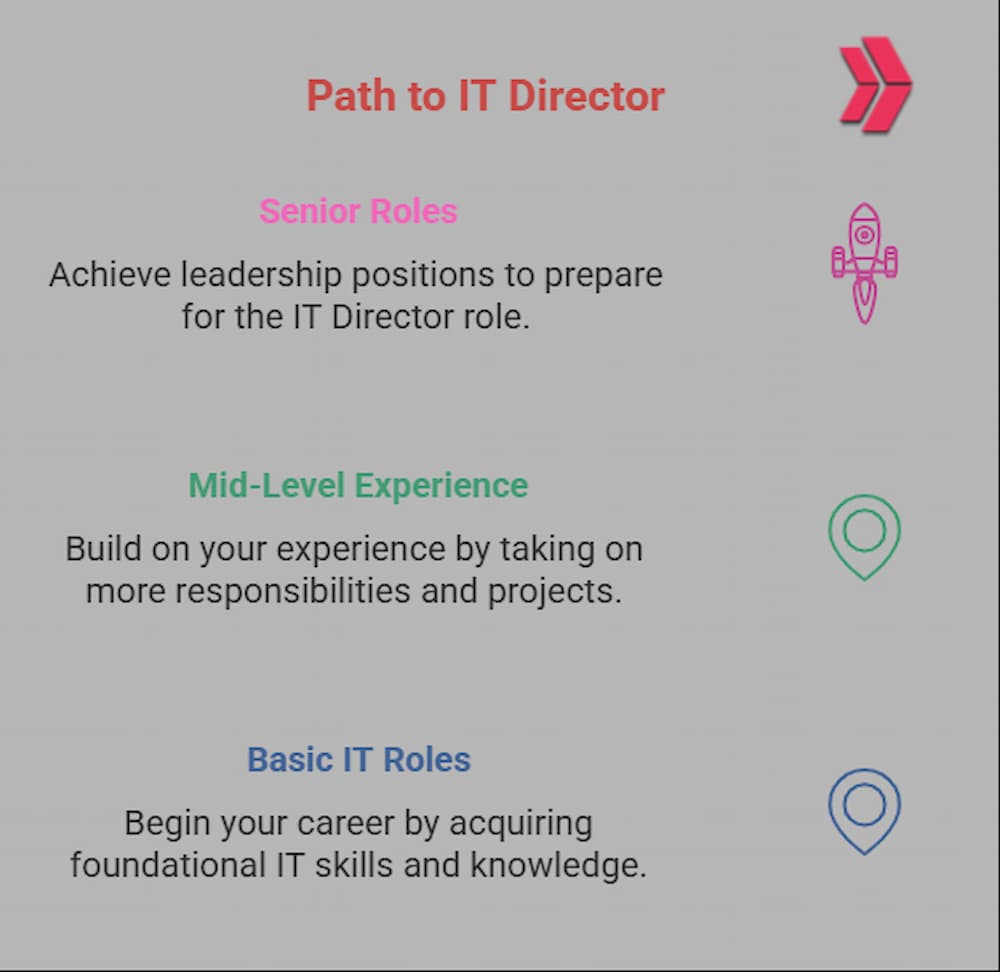
Education and Certifications
Formal Education
A Bachelor’s degree in Computer Science, Information Technology, or a similar field is usually required. This degree gives you the basic knowledge of computer systems, software, and networks. Many companies prefer candidates with a Master’s degree in IT Management or a Master of Business Administration (MBA). A graduate degree helps you learn more about planning, finance, and leadership.
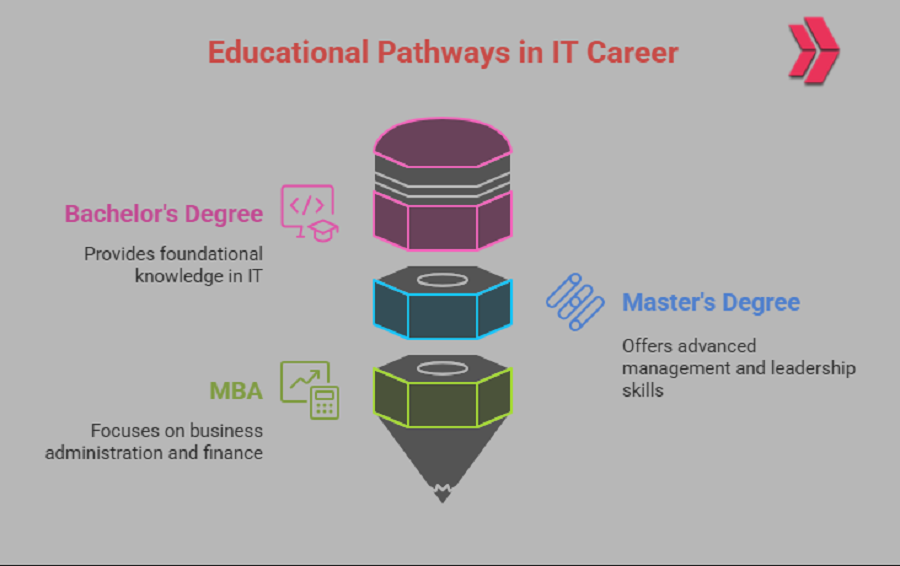
Certifications
Certifications enhance an education portfolio. Common choices include:
- CISSP: Shows skill in computer security.
- CGEIT: Proves skill in IT governance.
- PMP: Validates project management skills.
- ITIL Foundation: Covers IT service management.
- CISA: Focuses on audit and control.
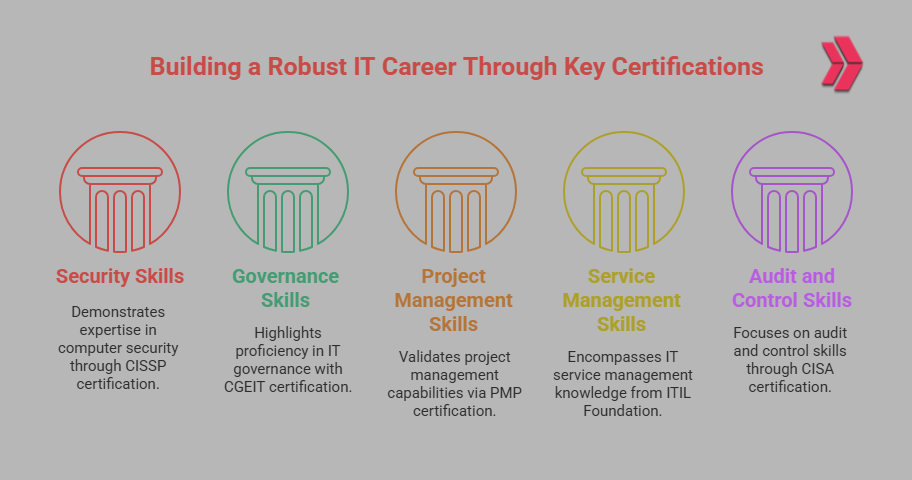
Certifications from cloud providers such as AWS, Azure, and Google Cloud are also valuable. These certificates show current knowledge of technology trends and methods.
What are the Essential Technical Skills for an IT Director?
Even in management, a strong technical base remains necessary. The following skills are essential:
- Network Management: Understanding network protocols and device configurations.
- Database Management: Managing and securing data.
- Cybersecurity: Keeping computer systems safe by studying methods to protect data and prevent attacks.
- Cloud Computing: Gaining experience with cloud platforms and learning to manage cloud services.
- Software and Hardware Knowledge: Knowing the basics of operating systems, servers, and key software tools.
- IT Asset Management: Tracking and managing equipment and software licenses.
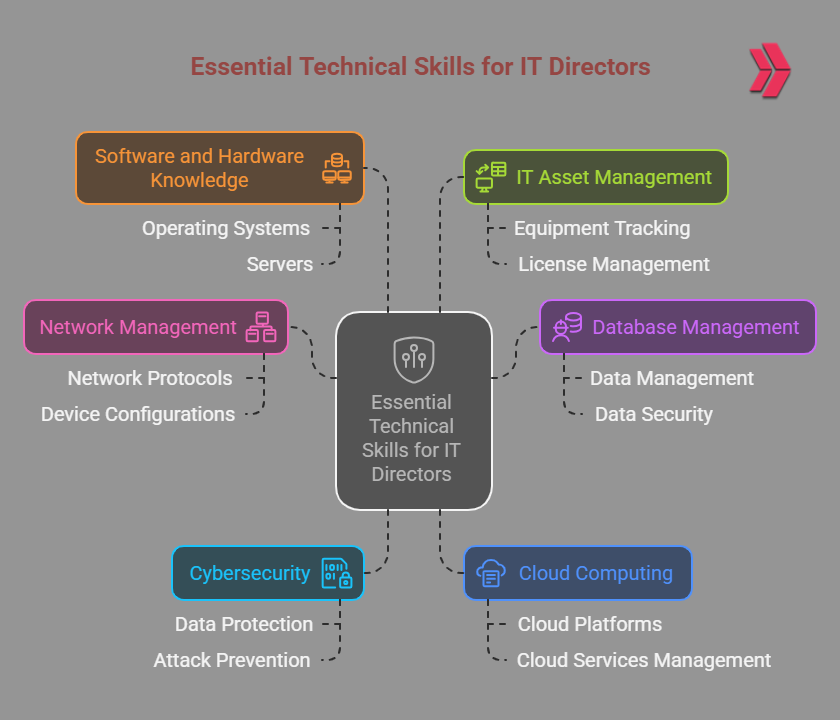
These skills help in understanding issues faced by technical teams and in making informed decisions.
What are the Essential Soft Skills for an IT Director?
Soft skills are also crucial. The following skills support technical knowledge and help manage daily challenges:
Leadership
Leaders guide teams by setting clear goals and coordinating efforts. Good leadership brings team members together and improves performance.
Communication
Clear and simple communication is vital to explain technical ideas in a way that all stakeholders can understand. Effective communication reduces misunderstandings and keeps projects on track.
Strategic Thinking
Planning for the future is a key requirement. An IT Director must set plans for new technology and budget needs. Strategic thinking supports choices that contribute to company growth.
Problem-Solving
Finding practical solutions to technical and management issues saves time and resources.
Budget Management
Handling budgets involves planning, controlling spending, and obtaining the best value from suppliers. This skill supports smooth operation of the IT department.

What are the Responsibilities of an IT Director?
An IT Director handles many tasks. Here are the IT director job responsibilities:
- Planning Technology Use: Creating plans for hardware, software, and network upgrades.
- Managing Teams: Leading IT staff, setting goals, and tracking progress.
- Collaborating with Senior Managers: Sharing IT plans with company leaders and aligning technology with business objectives.
- Controlling Budgets: Setting budgets and managing costs.
- Securing Systems: Establishing and enforcing rules for data protection and system access.
- Maintaining IT Infrastructure: Overseeing network operations, servers, and software systems.
- Managing Vendors: Choosing suppliers and handling contracts.
- Supporting Projects: Overseeing IT projects to ensure timely delivery and budget adherence.
Each responsibility requires clear plans and direct action to maintain system efficiency.
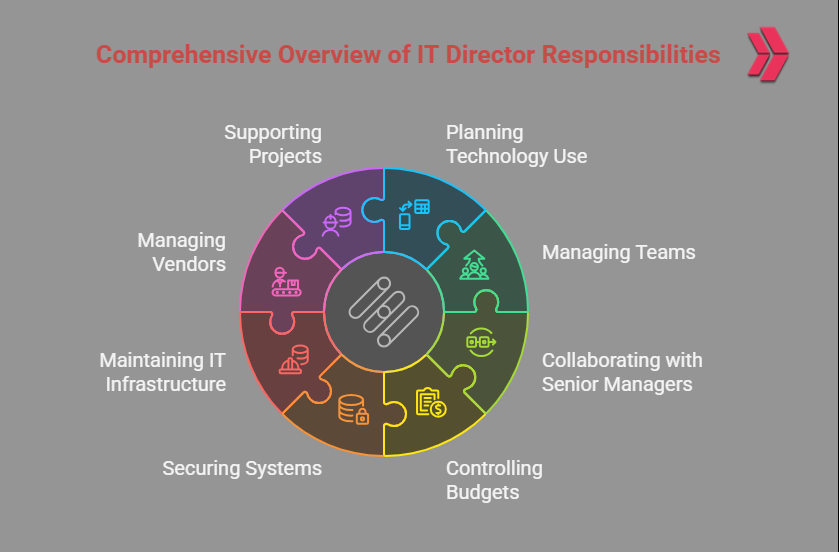
What are the Salary and Benefits of an IT Director?
An IT Director earns a competitive salary. In the United States, salaries range from about $127,000 to over $208,000 per year. Pay depends on factors such as location, company size, and industry type.
Large companies and high-cost cities generally offer higher pay. Many companies also offer bonuses, profit sharing, or stock options. Benefits often include health insurance, retirement plans, and paid time off. This salary range reflects the value placed on skilled IT leadership.
What Resources Are Available to Advance an IT Career?
Many resources are available to help advance an IT career. These resources offer training, networking, and advice. Examples include:
Professional Groups
Joining groups such as the Association of Information Technology Professionals (AITP) or the Association for Information Systems (AIS) provides access to meetings and events that foster professional connections.
Online Courses
Platforms such as Coursera, Udemy, and MIT Executive Education offer courses in IT management and leadership. These courses provide opportunities to learn new skills and earn certifications.
Bootcamps
IT bootcamps offer intensive training programs that focus on practical skills. These programs help develop knowledge in IT and management in a short period of time.
Mentorship
A mentor with experience in IT management can offer guidance and advice. Mentorship programs provide valuable insights for career advancement.
Industry News
Reading articles, blogs, and news about IT keeps knowledge current regarding new tools and methods. This ongoing learning ensures skills remain up to date.
These resources contribute to professional growth and support a career path in IT.
What Are the Challenges and Rewards of Being an IT Director?
Challenges
The IT Director role includes challenges such as tight deadlines, heavy workloads, security threats, and system maintenance issues. Problems with outdated technology and budget constraints may also arise. Addressing these challenges requires clear planning and prompt action.
Rewards
An IT Director earns a competitive salary and benefits. This role offers the chance to lead teams and improve company operations. It also provides the opportunity to plan new projects and see them through to completion. The position allows for meaningful contributions to the company’s success.
The balance of challenges and rewards underscores the strong appeal found in many IT jobs.
A Clear Path Forward
A career in IT builds gradually through experience. Starting with basic roles, gaining management experience, and advancing into senior roles creates a clear path to becoming an IT Director. Earning a degree, obtaining certifications, and developing technical and soft skills are key steps in this process.
Ongoing learning, participation in professional groups, online courses, and mentorship further support this career path. Staying informed about new technology and methods ensures that skills remain current. Each new achievement and skill builds a strong foundation for future roles in the IT career path.
Conclusion
This guide outlines the clear steps required to become an IT Director. The role and the necessary skills are explained in simple language. Building an IT career involves earning a degree, obtaining certifications, and developing both technical and soft skills. Experience in IT is gained in stages, leading to roles with greater responsibility. An IT Director manages budgets, secures systems, and leads teams, and the position offers competitive pay and benefits.
Following this clear path can lead to success in IT management. The information provided here serves as a roadmap for those who wish to advance in the field of IT leadership. Explore Clarusway bootcamp programs today to launch an IT career. Enroll now and take the next step toward a rewarding future in IT leadership.




